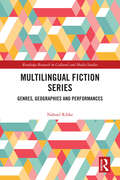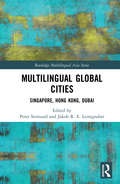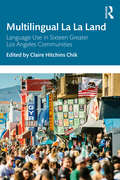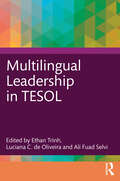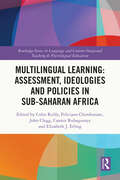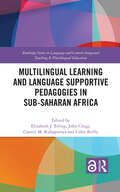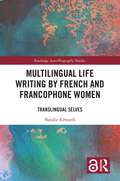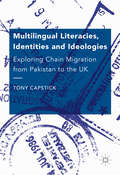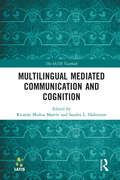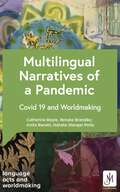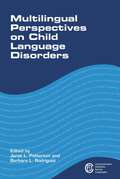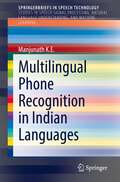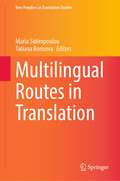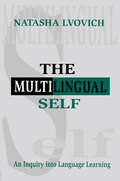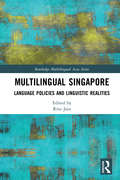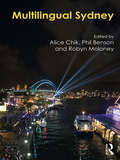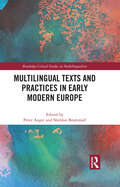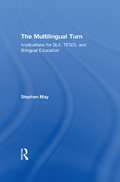- Table View
- List View
Multilingual Fiction Series: Genres, Geographies and Performances (Routledge Research in Cultural and Media Studies)
by Nahuel RibkeThis book explores the emergence and development of multilingual fiction series, a relatively new phenomenon propelled by the globalization of media industries and the consolidation of streaming platforms as central vectors in the production and consumption of audiovisual entertainment content. Through a detailed analysis of thriller, sitcom, and drama series, the book proposes an original qualitative and quantitative research methodology for the study of on-screen multilingual encounters, examining the relationship between multilingual speech and genre conventions. The book covers fiction series beyond English-speaking countries: alongside American productions, the analysis covers TV shows from Europe, Latin America, and the Middle East region. This interdisciplinary and original volume will interest scholars and students in film studies and media studies working on global media, as well as communication studies, television studies, sociolinguistics, media and cultural industries, and translation studies.
Multilingual Global Cities: Singapore, Hong Kong, Dubai (Routledge Multilingual Asia Series)
by Peter Siemund and Jakob R. E. LeimgruberThis volume sets out to investigate the linguistic ecologies of Singapore, Hong Kong, and Dubai, with chapters that combine empirical and theoretical approaches to the sociolinguistics of multilingualism. One important feature of this publication is that the five parts of the collection deal with such key issues as the historical dimension, language policies and language planning, contemporary societal multilingualism, multilingual language acquisition, and the localized Englishes of global cities. The first four sections of the volume provide a multi-levelled and finely-detailed description of multilingual diversity of three global cities, while the final section discusses postcolonial Englishes in the context of multilingual language acquisition and language contact.
Multilingual La La Land: Language Use in Sixteen Greater Los Angeles Communities
by Claire Hitchins ChikHome to immigrants from more than 140 countries speaking over 180 languages, Los Angeles is a microcosm of the world. While Los Angeles' ethnic enclaves have been the subject of study by researchers from a wide range of fields, these enclaves remain under-researched from a linguistic standpoint. Multilingual La La Land addresses the sociolinguistic landscape of the Greater Los Angeles (GLA) area, providing in-depth accounts of the sixteen most spoken languages other than English in the region. Each chapter introduces the history of the language in the L.A. region, uses census figures and residential densities to examine location-based and network-based speech communities, and discusses the patterns of usage that characterize the language, including motivations to maintain the language. How these patterns and trends bear on the vitality of each language is a central consideration of this book.
Multilingual Leadership in TESOL
by Ethan Trinh Luciana C. de Oliveira Ali Fuad SelviMultilingual Leadership in TESOL addresses issues related to leadership by and for multilingual individuals in the field. Chapters in this edited volume provide a strong theoretical grounding for multilingual leadership, use case studies and autoethnographies to showcase multilingual leaders’ backgrounds, and discuss challenges and opportunities for current and future leaders in TESOL. Presenting a wide view of leadership development in the field, this book includes contributions from top scholars from over a dozen countries, ethnicities and language backgrounds.Bringing together the dual focus on multilingualism and leadership, this is essential reading for scholars, researchers and future leaders in TESOL and applied linguistics.
Multilingual Learners and Academic Literacies: Sociocultural Contexts of Literacy Development in Adolescents
by Daniella Molle Edynn Sato Timothy Boals Carol A. HedgspethShifting the discourse from a focus on academic language to the more dynamic but less researched construct of academic literacies, this volume addresses three key questions: • What constitutes academic literacy? • What does academic literacy development in adolescent multilingual students look like and how can this development be assessed? • What classroom contexts foster the development of academic literacies in multilingual adolescents? The contributing authors provide divergent definitions of academic literacies and use dissimilar theoretical and methodological approaches to study literacy development. Nevertheless, all chapters reflect a shared conceptual framework for examining academic literacies as situated, overlapping, meaning-making practices. This framework foregrounds students’ participation in valued disciplinary literacy practices. Emphasized in the new college and career readiness standards, the notion of disciplinary practices allows the contributing authors to bridge the language/content dichotomy, and take a more holistic as well as nuanced view of the demands that multilingual students face in general education classrooms. The volume also explores the implications of the emphasis on academic literacy practices for classroom instruction, research, and policy.
Multilingual Learning: Assessment, Ideologies and Policies in Sub-Saharan Africa (Routledge Series in Language and Content Integrated Teaching & Plurilingual Education)
by Colin Reilly Feliciano Chimbutane John Clegg Casmir Rubagumya Elizabeth J. ErlingThis edited volume provides the follow up to Erling et al.’s (2021) Multilingual Learning and Language Supportive Pedagogies in Sub-Saharan Africa. The strategies put forward in Volume 1 included multilingual pedagogies that allow students to draw on their full linguistic repertoires, translanguaging and other language supportive pedagogies. While there is great traction in the pedagogical strategies proposed in Volume 1, limited progress has been made in terms of multilingual education in SSA. Thus, the main focus of this follow-up volume is to explore the question of why former colonial languages and monolingual approaches continue to be used as the dominant languages of education, even when we have multilingual pedagogies and materials that could and do work and despite substantial evidence that learners have difficulties when taught in a language they do not understand. This book offers perspectives to answer this question through focusing on the internal and external pressures which impact the capacity for implementing multilingual strategies in educational contexts at regional, national, and community levels. Chapters provide insights into how to better understand and work within these contemporary constraints and challenge dominant monoglossic discourses which inhibit the implementation of multilingual education in SSA. The volume focuses on three main areas which have proven to be stumbling blocks to the effective implementation of multilingual education to date, namely: Assessment, Ideology and Policy. An insightful collection that will be of great interest to academics, researchers, and practitioners in the fields of language education, language-in-education policy and educational assessments in the wide range of multilingual contexts in Africa.
Multilingual Learning and Language Supportive Pedagogies in Sub-Saharan Africa (Routledge Series in Language and Content Integrated Teaching & Plurilingual Education)
by Elizabeth J. ErlingThis edited collection provides unprecedented insight into the emerging field of multilingual education in Sub-Saharan Africa (SSA). Multilingual education is claimed to have many benefits, amongst which are that it can improve both content and language learning, especially for learners who may have low ability in the medium of instruction and are consequently struggling to learn. The book represents a range of Sub-Saharan school contexts and describes how multilingual strategies have been developed and implemented within them to support the learning of content and language. It looks at multilingual learning from several points of view, including ‘translanguaging’, or the use of multiple languages – and especially African languages – for learning and language-supportive pedagogy, or the implementation of a distinct pedagogy to support learners working through the medium of a second language. The book puts forward strategies for creating materials, classroom environments and teacher education programmes which support the use of all of a student’s languages to improve language and content learning. The contexts which the book describes are challenging, including low school resourcing, poverty and low literacy in the home, and school policy which militates against the use of African languages in school. The volume also draws on multilingual education approaches which have been successfully carried out in higher resource countries and lend themselves to being adapted for use in SSA. It shows how multilingual learning can bring about transformation in education and provides inspiration for how these strategies might spread and be further developed to improve learning in schools in SSA and beyond.
Multilingual Lexical Recognition in the Mental Lexicon of Third Language Users
by Weronika Szubko-SitarekThe monograph constitutes an attempt to demonstrate that trilinguals should be considered as learners and speakers in their own right as opposed to L2 learners with a view to enumerating consequences this would bring to third or additional language teaching. Its theoretical part offers an insight into the structure of the multilingual mental lexicon which is a product of the interplay of a whole array of cross-linguistic factors in the minds of multilingual speakers. The empirical part reports the findings of an empirical study which aimed to investigate connections which are formed between multiple languages in a multilingual mind. All the aspects, analyzed in the experiments are part of a broader question of how multilinguals make their lexical decisions and, more specifically, how they recognize words from different languages. The book closes with the discussion of the role of the obtained results for multilingual didactics as well as some possible areas for future research.
Multilingual Life Writing by French and Francophone Women: Translingual Selves (Routledge Auto/Biography Studies)
by Natalie EdwardsThis volume examines the ways in which multilingual women authors incorporate several languages into their life writing. It compares the work of six contemporary authors who write predominantly in French. It analyses the narrative strategies they develop to incorporate more than one language into their life writing: French and English, French and Creole, or French and German, for example. The book demonstrates how women writers transform languages to invent new linguistic formations and how they create new formulations of subjectivity within their self-narrative. It intervenes in current debates over global literature, national literatures and translingual and transnational writing, which constitute major areas of research in literary and cultural studies. It also contributes to debates in linguistics through its theoretical framework of translanguaging. It argues that multilingual authors create new paradigms for life writing and that they question our understanding of categories such as "French literature."
Multilingual Literacies, Identities and Ideologies
by Tony CapstickThis book explores the language and literacy practices which sustain transnational migration across generations and across traditional boundaries such as school and home. The author has conducted extensive fieldwork in Pakistan and the UK to study migration between the two countries. Individuals' access to the dominant literacies of migration are contrasted with the vernacular practices which migrants take up at home as part of their digital literacies. The study explores the blurring of boundaries between home and school as well as the blurring of boundaries between language varieties. Tracing access to literacy in this way also shines a light on the literacy mediators migrants turn to for help with English language learning and when trying to access the bureaucratic literacies of migration. The study ends by exploring how migrants use all of their language resources, not just English, to fit into their new homes once they have arrived in the UK.
Multilingual Mediated Communication and Cognition (The IATIS Yearbook)
by Ricardo Muñoz Martín; Sandra L. HalversonThis collection provides a snapshot of cutting-edge research in the rapidly developing area of cognitive approaches to multilingual mediated communication. The chapters cover important trends in current work, including: the increasing interaction between translation and interpreting research, the emergence of neuroscientific theories and methods, the role of emotion in translation processes, and the impact of cognitive aptitudes on translation performance. Exploring the interface with neighbouring research areas such as bilingualism, reading, and cognitive psychology, the book presents a variety of theoretical frameworks and constructs to support empirical research and theoretical development. The authors address new research areas, such as emotions and multisensory integration; apply new research constructs, such as eye-voice span; and expand the scope of cognitive translation studies to include agents other than the mediator. Documenting the growth in breadth and depth within cognitive translation and interpreting studies (CTIS) over the past decade, this is essential reading for all advanced students and researchers needing an up-to-date overview of cognitive translation and interpreting studies.
The Multilingual Mind
by Michael Sharwood Smith John TruscottLanguage lies at the heart of the way we think, communicate and view the world. Most people on this planet are in some sense multilingual. The Multilingual Mind explores, within a processing perspective, how languages share space and interact in our minds. The mental architecture proposed in this volume permits research across many domains in cognitive science to be integrated and explored within one explanatory framework, recasting compatible insights and findings in terms of a common set of terms and concepts. The MOGUL framework has already proven effective for shedding light on the relationship between processing and learning, metalinguistic knowledge, consciousness, optionality, crosslinguistic influence, the initial state, 'UG access', ultimate attainment, input enhancement, and even language instruction. This groundbreaking work will be essential reading for linguists working in language acquisition, multilingualism, language processing and for those working in related areas of psychology, neurology and cognitive science.
Multilingual Narratives of a Pandemic: Covid 19 and Worldmaking (Language Acts and Worldmaking)
by Various Professor Catherine BoyleWe narrate everything. We construct the world around us by telling its stories, shaping the language we use to describe what is happening to us; language that is used and adapted in the media in response to moments of crisis. This language in turn shapes how we see the world. This is what we call 'worldmaking'. When we look for solutions to problems, we so often start by telling stories to each other in our communities, stories that set a crisis in context, relate it to our historical experience, help us to understand it in the context of our local communities and contrast those stories to dominant narratives. In this way, language becomes a physical and material force in our world, through which we construct our personal, local, transnational and spiritual identities.'Worldmaking in the Time of COVID-19', the project that informs this book, was an early response to the experience of living through the COVID-19 pandemic - intended as a contribution to our collective understanding of the COVID-19 pandemic. Following comparison and analysis of over 1.1 million news articles from 117 countries in twelve different languages, this timely reflection follows the course of this investigation, with three main objectives: - to capture the languages of the early pandemic (January-April 2020); - to offer a transferable methodology for exploring world events in multiple languages; - and to share some of the key findings of researchers. Like all the volumes in the Language Acts and Worldmaking series, the overall aim is two-fold: to challenge widely-held views about language learning as a neutral instrument of globalisation and to innovate and transform language research, teaching and learning, together with Modern Languages as an academic discipline, by foregrounding its unique form of cognition and critical engagement. Specific aims are to:· propose new ways of bridging the gaps between those who teach and research languages and those who learn and use them in everyday contexts from the professional to the personal· put research into the hands of wider audiences· share a philosophy, policy and practice of language teaching and learning which turns research into action· provide the research, experience and data to enable informed debates on current issues and attitudes in language learning, teaching and research· share knowledge across and within all levels and experiences of language learning and teaching· showcase exciting new work that derives from different types of community activity and is of practical relevance to its audiences· disseminate new research in languages that engages with diverse communities of language practitioners.
Multilingual Narratives of a Pandemic: Covid 19 and Worldmaking (Language Acts and Worldmaking)
by Various Professor Catherine BoyleWe narrate everything. We construct the world around us by telling its stories, shaping the language we use to describe what is happening to us; language that is used and adapted in the media in response to moments of crisis. This language in turn shapes how we see the world. This is what we call 'worldmaking'. When we look for solutions to problems, we so often start by telling stories to each other in our communities, stories that set a crisis in context, relate it to our historical experience, help us to understand it in the context of our local communities and contrast those stories to dominant narratives. In this way, language becomes a physical and material force in our world, through which we construct our personal, local, transnational and spiritual identities.'Worldmaking in the Time of COVID-19', the project that informs this book, was an early response to the experience of living through the COVID-19 pandemic - intended as a contribution to our collective understanding of the COVID-19 pandemic. Following comparison and analysis of over 1.1 million news articles from 117 countries in twelve different languages, this timely reflection follows the course of this investigation, with three main objectives: - to capture the languages of the early pandemic (January-April 2020); - to offer a transferable methodology for exploring world events in multiple languages; - and to share some of the key findings of researchers. Like all the volumes in the Language Acts and Worldmaking series, the overall aim is two-fold: to challenge widely-held views about language learning as a neutral instrument of globalisation and to innovate and transform language research, teaching and learning, together with Modern Languages as an academic discipline, by foregrounding its unique form of cognition and critical engagement. Specific aims are to:· propose new ways of bridging the gaps between those who teach and research languages and those who learn and use them in everyday contexts from the professional to the personal· put research into the hands of wider audiences· share a philosophy, policy and practice of language teaching and learning which turns research into action· provide the research, experience and data to enable informed debates on current issues and attitudes in language learning, teaching and research· share knowledge across and within all levels and experiences of language learning and teaching· showcase exciting new work that derives from different types of community activity and is of practical relevance to its audiences· disseminate new research in languages that engages with diverse communities of language practitioners.
Multilingual Perspectives on Child Language Disorders
by Barbara L. Rodríguez Janet L. PattersonThis book investigates language disorders in children who speak languages other than, or in addition to, English. The chapters in the first section of the volume focus on language disorders associated with four different syndromes in multilingual populations and contexts. This section discusses language disorders associated with autism spectrum disorders, Down syndrome, fetal alcohol syndrome and Williams syndrome. The chapters in the second section of the book relate to language impairment in children who speak diverse languages, although the issues they address are relevant across languages and cultural contexts. The book also reviews assessment procedures and intervention approaches for diverse languages, including Bengali, Cantonese, French, Spanish, and Turkish. The volume aims to stimulate thoughtful clinical practice and further research in language disorders in multilingual populations.
Multilingual Phone Recognition in Indian Languages (SpringerBriefs in Speech Technology)
by K.E ManjunathThe book presents current research and developments in multilingual speech recognition. The author presents a Multilingual Phone Recognition System (Multi-PRS), developed using a common multilingual phone-set derived from the International Phonetic Alphabets (IPA) based transcription of six Indian languages - Kannada, Telugu, Bengali, Odia, Urdu, and Assamese. The author shows how the performance of Multi-PRS can be improved using tandem features. The book compares Monolingual Phone Recognition Systems (Mono-PRS) versus Multi-PRS and baseline versus tandem system. Methods are proposed to predict Articulatory Features (AFs) from spectral features using Deep Neural Networks (DNN). Multitask learning is explored to improve the prediction accuracy of AFs. Then, the AFs are explored to improve the performance of Multi-PRS using lattice rescoring method of combination and tandem method of combination. The author goes on to develop and evaluate the Language Identification followed by Monolingual phone recognition (LID-Mono) and common multilingual phone-set based multilingual phone recognition systems.
Multilingual Routes in Translation (New Frontiers in Translation Studies)
by Maria Sidiropoulou Tatiana BorisovaThis book tackles the interface between translation and pragmatics. It comprises case studies in English, Greek, Russian and Chinese translation practice, which highlight the potential of translation to interact with pragmatics and reshape meaning making in a target language in various pragmatically relevant ways. Fiction and non-fiction genres merge to suggest a rich inventory of interlingual transfer instances which can broaden our perception of what may be shifting in translation transfer. Authors use an emic approach (in addition to an etic one) to confirm results which they often present graphically. The book has a didactic perspective in that it shows how pragmatic awareness can regulate translator behaviour and is also useful in foreign language teaching, because it shows how important implicit knowledge can be, in shaping the message in a foreign language.
The Multilingual Self: An Inquiry Into Language Learning
by Natasha LvovichThis book relates the author's stories about how languages have integrated her being, and defined and formed her sense of self. The idea of writing autobiographical stories of her multilingual life came from her long-term commitment to foreign language teaching and from a recent, extremely rich and valuable experience teaching English to immigrants in the U.S. While reading and studying various aspects of second-language-related-theory -- linguistics, psychology, anthropology, and sociolinguistics literature -- the author realized how estranged language learners are from all the research, speculations, hypotheses, and achievements of scholarship. A Russian immigrant, the author tells stories to her ESL students to help them understand why and at what price successful language acquisition and acculturation is realistic. Not only can students learn from her stories which encourage discoveries about their own behaviors or problems, but they might want to respond and tell about their own struggles with a foreign language. By becoming writers and interpreters of her text and by making it their own, students can construct their own virtual texts. The stories told throughout are those of a language learner, who is also a linguist and language teacher. As such, they can bridge the gap between second language research and practical teaching and learning. Moreover, this book can help initiate language learners along with their teachers into scholarship. Second language teachers and graduate students preparing for a teaching career might see this book as an illustration and validation of the studied theory and an inner voice of their students at the same time. Multidisciplinary by nature, it can also be used in several college courses such as cultural anthropology, anthropo- and socio-linguistics, sociology, multicultural education, ethnography, bilingualism, and the study of immigrant experience. There are numerous applications of the book in the educational field at various levels of adult learning programs which might be determined by the objectives and by the instructor's vision of it in the curriculum. It is also intended as a message to the general public and to all thinking individuals in search of identity. It will popularize the idea of the importance of foreign language learning, language education, linguistic literacy, and metalinguistic awareness, of illuminating self-discovery through the treasure of multilingual experience, capable of giving birth to a new, sophisticated, spiritually complex and enriched multicultural identity.
Multilingual Singapore: Language Policies and Linguistic Realities (Routledge Multilingual Asia Series)
by Ritu JainThis volume brings together researchers whose analysis and insights provide a comprehensive and up-to-date account of Singapore’s rich linguistic diversity. Applying a combination of descriptive, empirical, and theoretical approaches, the authors investigate not only official languages such as English, Mandarin, Malay, and Tamil, but also minority languages such as the Chinese vernaculars and South Asian and Austronesian languages. The chapters in this volume trace the historical development, contemporary status, and functions of these languages, as well as potential scenarios for the future. Exploring the tension between language policies and linguistic realities in Singapore, the contributions in this volume capture the shifting educational, political, and societal priorities of the community through its past and contemporary present.
Multilingual Subjects: On Standard English, Its Speakers, and Others in the Long Eighteenth Century
by Daniel DeWispelareIn the eighteenth century, the British Empire pursued its commercial ambitions across the globe, greatly expanding its colonial presence and, with it, the reach of the English language. During this era, a standard form of English was taught in the British provinces just as it was increasingly exported from the British Isles to colonial outposts in North America, the Caribbean, South Asia, Oceania, and West Africa. Under these conditions, a monolingual politics of Standard English came to obscure other forms of multilingual and dialect writing, forms of writing that were made to appear as inferior, provincial, or foreign oddities.Daniel DeWispelare's Multilingual Subjects at once documents how different varieties of English became sidelined as "dialects" and asserts the importance of both multilingualism and dialect writing to eighteenth-century anglophone culture. By looking at the lives of a variety of multilingual and nonstandard speakers and writers who have rarely been discussed together—individuals ranging from slaves and indentured servants to translators, rural dialect speakers, and others—DeWispelare suggests that these language practices were tremendously valuable to the development of anglophone literary aesthetics even as Standard English became dominant throughout the ever-expanding English-speaking world.Offering a prehistory of globalization, especially in relation to language practices and politics, Multilingual Subjects foregrounds the linguistic multiplicities of the past and examines the way these have been circumscribed through standardized forms of literacy. In the process, DeWispelare seeks to make sense of a present in which linguistic normativity plays an important role in determining both what forms of writing are aesthetically valued and what types of speakers and writers are viewed as full-fledged bearers of political rights.
Multilingual Sydney
by Alice Chik Phil Benson Robyn MoloneyThe rise of global mobility has had a deep impact on the study of urban multilingualism. Once associated with research on minority speech communities and inner-city ethnolinguistic enclaves (Chinatowns, Little Italies, etc), it is now concerned much more with the use of multiple languages in diverse neighbourhoods across the city. In this book the authors take an innovative approach that builds on previously published work in two ways. First, it focuses on a single city and, second, it adopts a multidisciplinary approach to multilingualism. By examining the phenomenon of multilingualism in a single city from a range of perspectives this book paints a more comprehensive picture of the current dimensions of urban multilingualism. A unique feature of this book is the inclusion of contributions from scholars with expertise in education, geography, media, health communication and international studies, in addition to community practitioners. Sydney is the largest city in Australia and, on most counts, it is also among the most linguistically diverse cities in the world. As such it is an ideal site for a multidisciplinary study of urban multilingualism. The selection of 18 multidisciplinary case studies on multilingualism in Sydney, Australia represents some of the strongest and most innovative research on urban multilingualism in the world today. This book examines how multilingualism permeates institutional and everyday practice in the city, raising important questions about what a ‘multilingual city’ can and should be.
Multilingual Texts and Practices in Early Modern Europe (Routledge Critical Studies in Multilingualism)
by Peter Auger Sheldon BrammallThis collection offers a cross-disciplinary exploration of the ways in which multilingual practices were embedded in early modern European literary culture, opening up a dynamic dialogue between contemporary multilingual practices and scholarly work on early modern history and literature. The nine chapters draw on translation studies, literary history, transnational literatures, and contemporary sociolinguistic research to explore how multilingual practices manifested themselves across different social, cultural and institutional spaces. The exploration of a diverse range of contexts allows for the opportunity to engage with questions around how individual practices shape national and transnational language practices and literatures, the impact of multilingual practices on identity formation, and their implications for creative innovations in bilingual and multilingual texts. Taken as a whole, the collection paves the way for future conversations on what early modern literary studies and present-day multilingualism research might learn from one another and the extent to which historical texts might supply precedents for contemporary multilingual practices. This book will be of particular interest to students and scholars in sociolinguistics, early modern studies in history and literature, and comparative literature.
The Multilingual Turn: Implications for SLA, TESOL, and Bilingual Education
by Stephen MayDrawing on the latest developments in bilingual and multilingual research, The Multilingual Turn offers a critique of, and alternative to, still-dominant monolingual theories, pedagogies and practices in SLA, TESOL, and bilingual education. Critics of the ‘monolingual bias’ argue that notions such as the idealized native speaker, and related concepts of interlanguage, language competence, and fossilization, have framed these fields inextricably in relation to monolingual speaker norms. In contrast, these critics advocate an approach that emphasizes the multiple competencies of bi/multilingual learners as the basis for successful language teaching and learning. This volume takes a big step forward in re-situating the issue of multilingualism more centrally in applied linguistics and, in so doing, making more permeable its key sub-disciplinary boundaries – particularly, those between SLA, TESOL, and bilingual education. It addresses this issue head on, bringing together key international scholars in SLA, TESOL, and bilingual education to explore from cutting-edge interdisciplinary perspectives what a more critical multilingual perspective might mean for theory, pedagogy, and practice in each of these fields.
The Multilingual Turn in Languages Education
by Jean Conteh Gabriela MeierStarting from the key idea that learners and teachers bring diverse linguistic knowledge and resources to education, this book establishes and explores the concept of the 'multilingual turn' in languages education and the potential benefits for individuals and societies. It takes account of recent research, policy and practice in the fields of bilingual and multilingual education as well as foreign and second language education. The chapters integrate theory and practice, bringing together researchers and practitioners from five continents to illustrate the effects of the multilingual turn in society and evaluate the opportunities and challenges of implementing multilingual curricula and activities in a variety of classrooms. Based on the examples featured, the editors invite students, teachers, teacher educators and researchers to reflect on their own work and to evaluate the relevance and applicability of the multilingual turn in their own contexts.
Multilingual Universities in South Africa
by Liesel Hibbert Christa van der WaltFocusing on the use of African languages in higher education, this book showcases South African higher education practitioners' attempts to promote a multilingual ethos in their classes. It is a first-time overview of multilingual teaching and learning strategies that have been tried and tested in a number of higher education institutions in South Africa. Despite language-in-education policies that extol the virtues of multilingualism, practice remains oriented towards English-only learning and teaching. In the multilingual contexts of local campuses, this book shows how students and lecturers attempt to understand their multiple identities and use the available languages to create multilingual learning environments.
